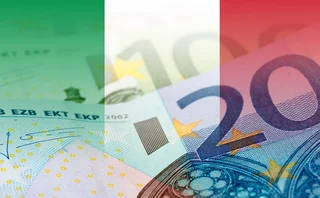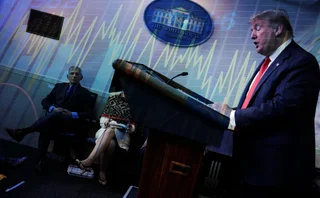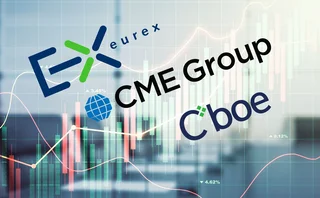
Primary dealers lose derivatives market-share, says BIS triennial survey
Trading in over-the-counter currency and interest rate derivatives has risen by 112% since 2001, but the market-share of reporting dealers has fallen, according to the latest survey conducted by the Bank for International Settlements (BIS).
This is matched by a rise in derivatives use by smaller commercial banks, mutual funds, hedge funds and insurance companies, which the survey attributes to the turbulent nature of financial markets since 2001. The market-share of these non-reporting financial institutions rose to 43% of OTC turnover, up from 29% in 2001, leaving them similar in size to the reporting dealers. The remainder of the market represents end-users such as corporates and governments, which have seen their share of activity increase by 216% to $79 billion.
The survey, which uses trading data supplied by central banks from April, shows daily average trading volumes reaching $1.2 trillion, a figure that includes all OTC currency swaps and options, and interest rate derivatives.
Exchange-traded derivatives volumes rose by a similar amount: 120% for currency derivatives and 108% for interest rate derivatives. The survey claims the OTC market’s increase reflects broader market factors rather than a shift away from exchange trading.
Interest rate contracts, the largest sector of the OTC derivatives market, grew in volume by 110%, boosted by a 128% rise in US dollar-denominated activity. Interest rate options now represent 17% of the market, tripling in size since 2001. Trading in forward-rate agreements (FRAs) and interest rate swaps roughly doubled for both instruments. The increases in interest rate derivatives trading can be partially explained by the shift in expectation about future US interest rates during April. US dollar-denominated options grew considerably to reach $91 billion, a rise of 675%.
Interest rate contracts denominated in euros rose by 100%, with euro options showing a 500% increase to reach $57 billion, up from $11 billion in 2001. Euro interest rate swaps, the benchmark for European fixed income due to the absence of homogeneous government bond markets, grew by 66%. Euro-denominated interest rate derivatives volumes are larger than dollar volumes – $461 billion compared with $347 billion – as was the case in 2001. The survey attributes part of the increase in euro derivatives volumes to the 25% depreciation of the dollar against the euro since the BIS’ last triennial survey.
Japanese economic recovery and its associated shift in interest rate expectations has boosted yen interest rate swap trading, which recovered from its drop in 2001 to reach daily volumes of $35 billion, a 119% rise. Meanwhile, sterling interest rate swap trading was up 157% to $59 billion a day, while overall sterling interest rate derivatives trading grew 143% to $90 billion.
In the foreign exchange markets, derivatives trading was up 109% to $140 billion, although the sector’s total share of the OTC derivatives market remained fairly static at 12%. Trading was boosted by dollar contracts, especially dollar/euro and dollar/yen pairings, up 124% and 58% respectively. Turnover for other euro-denominated contracts rose 130% to $23 billion. Currency options, the largest group of non-traditional foreign exchange products, exhibited a trading increase of 95% to $117 billion. Currency swaps trading hit $21 billion, up 200%.
Cross-border activity now accounts for 60% of all trading, continuing its steady rise from 52% in 1998.
The survey is conducted every three years by the Basel-based BIS, which collects data from 52 central banks and monetary authorities on traditional foreign exchange market turnover, as well as interest rate and currency derivatives.
Only users who have a paid subscription or are part of a corporate subscription are able to print or copy content.
To access these options, along with all other subscription benefits, please contact info@risk.net or view our subscription options here: http://subscriptions.risk.net/subscribe
You are currently unable to print this content. Please contact info@risk.net to find out more.
You are currently unable to copy this content. Please contact info@risk.net to find out more.
Copyright Infopro Digital Limited. All rights reserved.
As outlined in our terms and conditions, https://www.infopro-digital.com/terms-and-conditions/subscriptions/ (point 2.4), printing is limited to a single copy.
If you would like to purchase additional rights please email info@risk.net
Copyright Infopro Digital Limited. All rights reserved.
You may share this content using our article tools. As outlined in our terms and conditions, https://www.infopro-digital.com/terms-and-conditions/subscriptions/ (clause 2.4), an Authorised User may only make one copy of the materials for their own personal use. You must also comply with the restrictions in clause 2.5.
If you would like to purchase additional rights please email info@risk.net
More on Markets
Franklin Templeton dethrones MSIM as top FX options user
Counterparty Radar: MSIM continued to cut RMB positions in Q3, while Franklin Templeton increased G10 trades
Lenders scramble to get ahead of Italian fallback mandate
New law requiring robust fallbacks for Euribor will take effect on January 10
FX automation key to post-T+1 success, say custodians
Custody banks saw uptick in demand for automated FX execution to tackle T+1 challenges
Review of 2024: as markets took a breather, firms switched focus
In the absence of major crises and rules deadlines, financial firms revamped strategy, services and practices
Cboe plans Q2 dispersion futures listing
Expectations of post-US-election uncertainty drives launch, and could help bank equity desks hedge OTC risks
Futures exchanges look to ride credit ETF wave
Proponents hope for increased buy-side trading, with three exchanges competing for market share
Doubts raised over new FX platform disclosures
New disclosure sheet template will require platforms to outline how they charge for data
Pimco and Vanguard slash FX forwards trading with BNP Paribas
Counterparty Radar: French bank sees its notional with mutual funds halve







